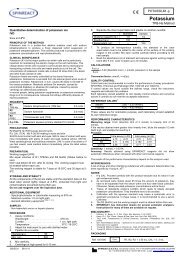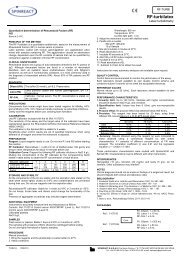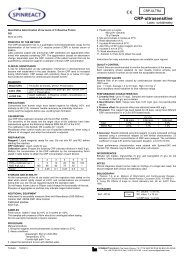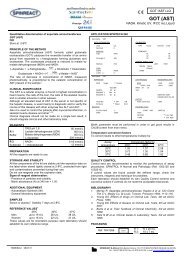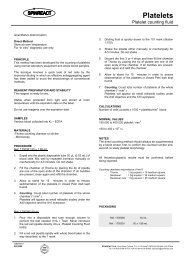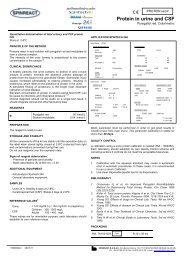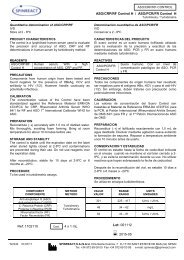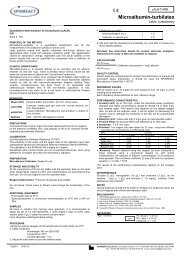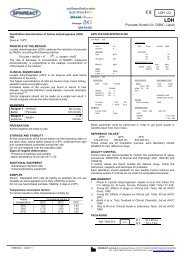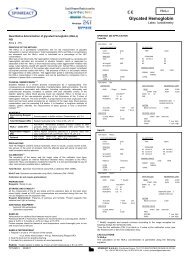Calcium
Calcium - Spinreact
Calcium - Spinreact
- No tags were found...
You also want an ePaper? Increase the reach of your titles
YUMPU automatically turns print PDFs into web optimized ePapers that Google loves.
CALCIUM-A III<br />
<strong>Calcium</strong><br />
Arsenazo III. Colorimetric<br />
Quantitative determination of calcium<br />
IVD<br />
Store at 2-8ºC<br />
PRINCIPLE OF THE METHOD<br />
<strong>Calcium</strong> with Arsenazo III (1,8-Dihydroxy-3,6-disulpho-2,7-<br />
naphthalene-bis (azo)-dibenzenearsonic acid), at neutral pH,<br />
yields a blue colored complex.<br />
The intensity of the colour formed is proportional to the calcium<br />
concentration in the sample 1,2,3 .<br />
CLINICAL SIGNIFICANCE<br />
<strong>Calcium</strong> is the most abundant and one of the most important<br />
minerals in the human body. Approximately 99% of body calcium<br />
is found in bones.<br />
A decrease in albumin level causes a decrease in serum calcium.<br />
Low levels of calcium are found in hypoparathyroidism,<br />
pseudohypoparathyroidism, vitamin D deficiency, malnutrition and<br />
intestinal malabsortion.<br />
Among causes of hypercalcemia are cancers, large intake of<br />
vitamin D, enhaced renal retention, osteoporosis, sarcosidosis,<br />
thyrotoxicosis, hyperparathyroidism 1,6,7 .<br />
Clinical diagnosis should not be made on a single test result; it<br />
should integrate clinical and other laboratory data.<br />
REAGENTS<br />
R<br />
Arsenazo III<br />
PREPARATION<br />
The reagent is ready to use.<br />
Imidazol Buffer pH 6.5<br />
Arsenazo III<br />
100 mmol/L<br />
120 mmol/L<br />
STORAGE AND STABILITY<br />
All the components of the kit are stable until the expiration date on<br />
the label when stored tightly closed at 2-8ºC, protected from light<br />
and contaminations are prevented during their use.<br />
Do not use reagents over the expiration date.<br />
Signs of reagent deterioration:<br />
- Presence of particles and turbidity.<br />
- Blank absorbance (A) at 660 nm 0.50.<br />
ADDITIONAL EQUIPMENT<br />
- MINDRAY BS-120 / BS-200E Autoanalyzer.<br />
- General laboratory equipment (Note 1, 2) .<br />
SAMPLES<br />
- Serum or plasma 1 : Separated from cells as rapidly as possible.<br />
Blood anticoagulants with oxalate or EDTA are not acceptable<br />
since these chemicals will strongly chelate calcium.<br />
- Urine 1 : Collect 24 hour urine specimen in calcium free<br />
containers. The collecting bottles should contain 10 ml of diluted<br />
Nitric acid (50% v/v). Record the volume.<br />
Dilute a sample 1/2 in distilled water. Mix. Multiply results by 2<br />
(dilution factor).<br />
Stability of the samples: <strong>Calcium</strong> is stable 10 days at 2-8ºC.<br />
REFERENCE VALUES 1<br />
Serum or plasma:<br />
Adults 8.5-10.5 mg /dL 2.1-2.6 mmol/L<br />
Children 10 -12 mg/dL 2.5 - 3 mmol/L<br />
Newborns 8 -13 mg/dL 2 - 3.25 mmol/L<br />
Urine:<br />
Adults 50 - 300 mg/24h 1.25 - 7.5 mmol/24h<br />
Children 80 -160 mg/24h 2 - 4 mmol/24h<br />
These values are for orientation purpose; each laboratory should<br />
establish its own reference range.<br />
MINDRAY BS-120 / BS-200E APPLICATION<br />
PARAMETERS<br />
Test Ca / Ca R1 300 / 300<br />
Nº ** R2 *<br />
Full Name Ca / Ca Sample volume 3 / 3<br />
Standard Nº<br />
Blank parameter must be performed in order to get good results in<br />
CALIB screen from main menu. The blank calibration is stable until 14<br />
days. After this period the blank parameter must be performed again in<br />
order to validate the calibration.<br />
QUALITY CONTROL<br />
Control sera and calibrators are recommended to monitor the<br />
performance of assay procedures: SPINTROL H Calibrator, SPINTROL<br />
H Normal and Pathologic (Ref. 1002011, 1002120 and 1002210).<br />
If control values are found outside the defined range, check the<br />
instrument, reagents and technique for problems.<br />
Each laboratory should establish its own Quality Control scheme and<br />
corrective actions if controls do not meet the acceptable tolerances.<br />
NOTES<br />
1. It is recommended to use disposable material. If glassware is used<br />
the material should be scrupulously cleaned with diluted 1/1 HNO 3<br />
in water and then thoroughly rinsed it with distilled water.<br />
2. Most of the detergents and water softening products used in the<br />
laboratories contain chelating agents. A defective rinsing will<br />
invalidate the procedure.<br />
3. Calibration with the aqueous standard may cause a systematic<br />
error in automatic procedures. In these cases, it is recommended<br />
to use a serum Calibrator.<br />
4. Use clean disposable pipette tips for its dispensation.<br />
BIBLIOGRAPHY<br />
1. Farell E C. <strong>Calcium</strong>. Kaplan A et al. Clin Chem The C.V. Mosby Co. St<br />
Louis. Toronto. Princeton 1984; 1051-1255 and 418.<br />
2. Kessler G. et al. Clin Chem Vol 10, No 8 1964; 686-706.<br />
3. Connerty H. V. et al. Am J Clin Path Vol 45, No 3 1996; 200-296.<br />
4. Young DS. Effects of drugs on Clinical Lab. Tests, 4th ed AACC Press,<br />
1995.<br />
5. Young DS. Effects of disease on Clinical Lab. Tests, 4th ed. AACC 2001.<br />
6. Burtis A. et al. Tietz Textbook of Clinical Chemistry, 3rd ed. AACC 1999.<br />
7. Tietz N W et al. Clinical Guide to Laboratory Tests, 3rd ed. AACC 1995.<br />
PACKAGING<br />
Ref: MI1001065<br />
Cont.<br />
R: 6 x 30 mL<br />
R1 Blank<br />
Reac. Type Endpoint / Endpoint Mixed Rgt Blank<br />
Pri. Wavelength 630 / 660 Linearity Range 2.0 mg/dL 30.0 mg/dL<br />
Sec. Wavelength Linearity Limit *<br />
Direction Increase / Increase Substrate Limit *<br />
Reac. Time 1_10 / 0_10 Factor *<br />
Incuba. Time Prozone check *<br />
Units mg/dL / mg/dL q1 q2<br />
Precision 0.1 / 0.1 q3 q4<br />
CALIBRATION (Cal + Rgt Blk)<br />
Rule<br />
Sensitivity 1 / 1<br />
Replicates 2 / 2<br />
Interval (days) 0 / 0<br />
Difference Limit<br />
SD<br />
Blank Response<br />
Error Limit<br />
Correlation Coefficient<br />
PC<br />
One-point Linear / Two-point Linear<br />
Abs<br />
MIBSIS09-I 17/01/13 SPINREACT,S.A./S.A.U. Ctra.Santa Coloma, 7 E-17176 SANT ESTEVE DE BAS (GI) SPAIN<br />
Tel. +34 972 69 08 00 Fax +34 972 69 00 99. e-mail: spinreact@spinreact.com
CALCIUM-A III<br />
Calcio<br />
Arsenazo III. Colorimétrico<br />
Determinación cuantitativa de calcio<br />
IVD<br />
Conservar a 2-8ºC<br />
PRINCIPIO DEL METODO<br />
El calcio, en medio neutro, forma un complejo de color azul con<br />
arsenazo III (ácido 1,8-dihidroxi-3,6-disulfo-2,7-naftalenenbis(azo)-dibenzenarsónico).<br />
La intensidad de color es directamente proporcional a la cantidad<br />
de calcio existente en la muestra 1,2,3 .<br />
SIGNIFICADO CLINICO<br />
El calcio es el mineral más abundante e importante del cuerpo<br />
humano, el 99 % se halla en los huesos.<br />
Una disminución de los niveles de albúmina causa una<br />
disminución del calcio en suero. Niveles bajos de calcio pueden<br />
atribuirse a hipoparatiroidismo, pseudohipoparatiroidismo, déficit<br />
de vitamina D, malnutrición o mala absorción<br />
La mayoría de las causas de hipercalcemia son debidas a<br />
enfermedades oncológicas, intoxicación por vitamina D, aumento<br />
de la retención renal, osteoporosis, sarcosidosis, tirotoxicosis e<br />
hiperparatiroidismo 1,6,7 .<br />
El diagnostico clínico debe realizarse teniendo en cuenta todos<br />
los datos clínicos y de laboratorio.<br />
REACTIVOS<br />
R<br />
Arsenazo III<br />
Tampón imidazol pH 6,5<br />
Arsenazo III<br />
PREPARACION<br />
Reactivo está listo para su uso.<br />
100 mmol/L<br />
120 mmol/L<br />
CONSERVACION Y ESTABILIDAD<br />
Todos los componentes del kit son estables, hasta la fecha de<br />
caducidad indicada en la etiqueta, cuando se mantienen los<br />
frascos bien cerrados a 2-8ºC, protegidos de la luz y se evita su<br />
contaminación. No usar reactivos fuera de la fecha indicada.<br />
Indicadores de deterioro de los reactivos:<br />
- Presencia de partículas y turbidez.<br />
- Absorbancia (A) del Blanco a 660 nm 0,50.<br />
MATERIAL ADICIONAL<br />
- Autoanalizador MINDRAY BS-120 / BS-200E.<br />
- Equipamiento habitual de laboratorio (Nota 1, 2) .<br />
MUESTRAS<br />
- Suero o plasma 1 : Separado lo antes posible de los hematies. No<br />
usar oxalato o EDTA como anticoagulantes ya que interfieren<br />
en la determinación del calcio.<br />
- Orina 1 : Efectuar la recogida de orina de 24 horas en recipientes<br />
libres de calcio. Antes de la recogida adicionar al contenedor 10<br />
mL de ácido nítrico al 50% (v/v). Anotar el volumen.<br />
Diluir la orina 1/2 en agua destilada para su análisis. Mezclar.<br />
Multiplicar el resultado obtenido por 2 (factor de dilución).<br />
Estabilidad de la muestra: El calcio es estable 10 días a 2-8ºC.<br />
VALORES DE REFERENCIA 1<br />
Suero o plasma:<br />
Adultos 8,5-10,5 mg /dL 2,1-2,6 mmol/L<br />
Niños 10-12 mg/dL 2,5-3 mmol/L<br />
Recién nacidos 8-13 mg/dL 2-3,2 mmol/L<br />
Orina:<br />
Adultos 50-300 mg/24 h 1,25-7,5 mmol/24 h<br />
Niños 80-160 mg/24 h 2-4 mmol/24 h<br />
Estos valores son orientativos. Es recomendable que cada<br />
laboratorio establezca sus propios valores de referencia.<br />
APLICACIÓN AL MINDRAY BS-120 / BS-200E<br />
PARAMETROS<br />
Nombre Abrev Ca / Ca R1 300 / 300<br />
Numero ** R2 *<br />
Nombre Ca / Ca Volumen muestra 3 / 3<br />
Num standard<br />
Es necesario solicitar el blanco en este parámetro para obtener resultados<br />
correctos en la pantalla principal de CALIB. La Calibración junto al blanco<br />
de reactivo es estable hasta 14 días. Pasado este período es necesario<br />
solicitar de nuevo el blanco de reactivo para hacer validar la calibración.<br />
CONTROL DE CALIDAD<br />
Es conveniente calibrar y analizar junto con las muestras sueros control y<br />
calibradores valorados: SPINTROL H Calibrador, SPINTROL H Normal y<br />
Patológico (Ref. 1002011, 1002120 y 1002210).<br />
Si los valores hallados se encuentran fuera del rango de tolerancia, revisar<br />
el instrumento, los reactivos y el calibrador.<br />
Cada laboratorio debe disponer su propio Control de Calidad y establecer<br />
correcciones en el caso de que los controles no cumplan con las<br />
tolerancias.<br />
NOTAS<br />
1. Se recomienda utilizar material de plástico de un solo. Si se usa<br />
material de vidrio deberá lavarse con ácido nítrico diluido con agua<br />
(1/1), enjuagar varias veces con agua destilada y secar antes de su<br />
uso.<br />
2. La mayoría de detergentes destinados a uso del laboratorio contienen<br />
agentes quelantes. Trazas de los mismos, como consecuencia de un<br />
mal aclarado del material, invalida la determinación.<br />
3. La calibración con el Patrón acuoso puede dar lugar a errores<br />
sistemáticos en métodos automáticos. En este caso, se recomienda<br />
utilizar calibradores séricos.<br />
4. Usar puntas de pipeta desechables limpias para su dispensación.<br />
BIBLIOGRAFIA<br />
1. Farell E C. <strong>Calcium</strong>. Kaplan A et al. Clin Chem The C.V. Mosby Co. St Louis.<br />
Toronto. Princeton 1984; 1051-1255 and 418.<br />
2. Kessler G. et al. Clin Chem 1964; 10 (8); 686-706.<br />
3. Connerty H. V. et al. Am J Clin Path 1996; 45 (3); 200-296.<br />
4. Young DS. Effects of drugs on Clinical Lab. Tests, 4th ed AACC Press, 1995.<br />
5. Young DS. Effects of disease on Clinical Lab. Tests, 4th ed. AACC 2001.<br />
6. Burtis A. et al. Tietz Textbook of Clinical Chemistry, 3rd ed. AACC 1999.<br />
7. Tietz N W et al. Clinical Guide to Laboratory Tests, 3rd ed. AACC 1995.<br />
PRESENTACION<br />
Ref: MI1001065<br />
Cont.<br />
Blanco R1<br />
Modo P. Final / P. Final Blanco mezcla reactivo<br />
Long onda primaria 630 / 660 Rango linealidad 2.0 mg/dL 30.0 mg/dL<br />
Long onda secundaria Límite linealidad *<br />
Dirección Aumen / Aumen Límite Substrato *<br />
Tiempo reacción 1_10 / 0_10 Factor *<br />
Tiempo Incubación Efecto Prozona *<br />
Unidades mg/dL / mg/dL q1 q2<br />
Precision 0.1 / 0.1 q3 q4<br />
CALIBRACIÓN (Cal + Bl reactivo)<br />
Tipo curva<br />
Sensibilidad 1 / 1<br />
Replicados 2 / 2<br />
Intervalos (días) 0 / 0<br />
Límite aceptación<br />
Desviación Estandard<br />
Respuesta del Blanco<br />
Error Límite<br />
Coeficiente correlación<br />
PC<br />
Lineal un punto / Lineal dos puntos<br />
R: 6 x 30 mL<br />
Abs<br />
MIBSIS09-E 17/01/13 SPINREACT,S.A./S.A.U. Ctra.Santa Coloma, 7 E-17176 SANT ESTEVE DE BAS (GI) SPAIN<br />
Tel. +34 972 69 08 00 Fax +34 972 69 00 99. e-mail: spinreact@spinreact.com



